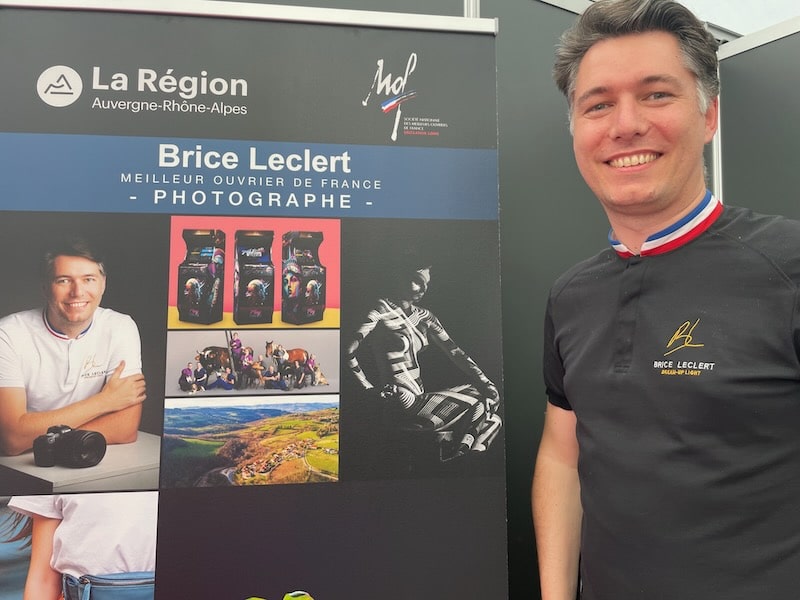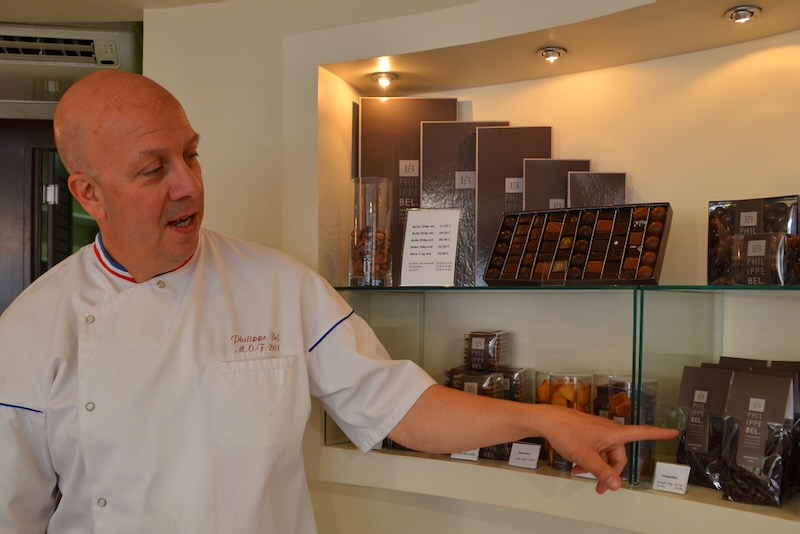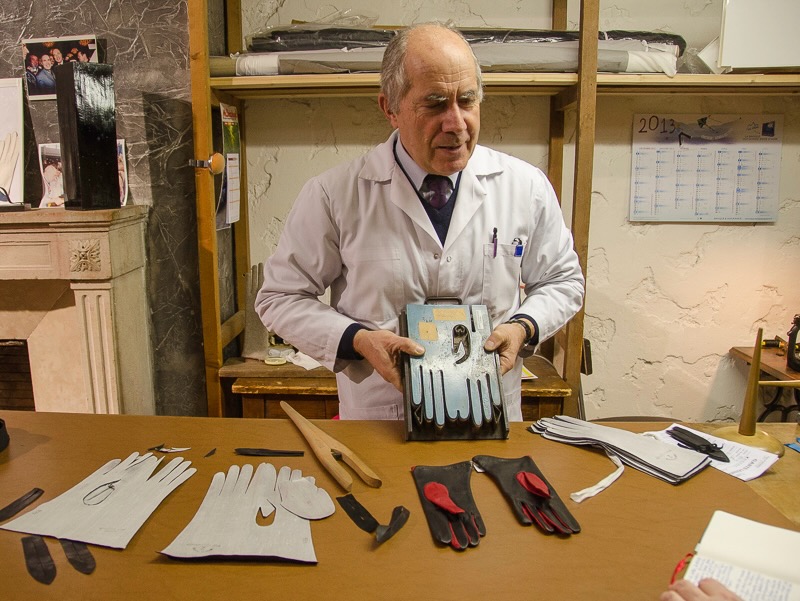Unsure about your French table manners? Click Here to download > > How to avoid these 10 food etiquette mistakes !
- Home ›
- Made in France ›
- Meilleur Ouvrier de France (MOF)
How To Achieve Perfection: The Meilleur Ouvrier De France Competition
Published 18 May 2025 by Leyla Alyanak — Parisian by birth, Lyonnaise by adoption, historian by passion
This article explores the Meilleur Ouvrier de France (MOF), France’s highest honor for manual trades, awarded through a demanding national competition. It highlights the history, emotional toll and cultural importance of the title, which goes far beyond the world of haute cuisine.
I did a double-take.
A rural French country fair called BugeyExpo. A photographer’s folding stand. And there he was, Brice Leclert, wearing the hallowed tricolor band around his neck — the one that labels him a Meilleur Ouvrier de France, or MOF, France’s highest distinction for manual trades.
I had to stop and chat, because I wasn't aware photographers could win this distinction.
France prides itself on craftsmanship, so clearly, you can expect excellence — even perfection — in the most unexpected places.
The MOF, or Best Worker of France, is a distinction that separates the best from the merely brilliant.
We mostly tend to identify the MOF distinction with great chefs, so I was surprised to learn it covers some 200 trades split into 16 categories. It certainly goes far beyond the kitchen...
 Brice Leclert, at his stand in the rural town of Belley, proudly displays his tricolor neck band ©OffbeatFrance
Brice Leclert, at his stand in the rural town of Belley, proudly displays his tricolor neck band ©OffbeatFranceHow can you tell someone is a MOF?
The most visible clue is that discreet blue-white-and-red band around their neck — or sometimes stitched into a breast pocket. The tricolor echoes the French flag, a visible sign that this is not just a professional title, but a national one.
Less visible is the national competition they must confront to earn the right to wear it.
A national obsession with craft
It all began in 1924, in the aftermath of World War I. Mechanization was expanding, and craftsmanship, once a pillar of France's national identity, was being sidelined.
To push back against this loss of talent and soul, France launched a public competition to highlight excellence in manual trades by holding its first Exposition Nationale du Travail, which marked the debut of the Meilleur Ouvrier de France. This elusive title has been awarded every four years since.
Some years, no one wins. The judges simply conclude that no candidate, however skilled, has reached its dizzying standard.
Those who do are entitled to wear that modest tricolor band for life. It draws attention, and not always the kind people expect.
“People assume it’s just for chefs. They’re surprised to see it on a photographer. That’s when I get to explain what it really means,” Leclert explained.
"It takes over your life"
Becoming a MOF is not for the faint-hearted.
Preparation takes years and the process is grueling. Candidates face several jury presentations, long-term assignments, and high-pressure demonstrations with the clock ticking and stress mounting.
In Leclert’s case, it was more than a jury.
“We were given an assignment in a disassembled studio,” he told me. “We had to bring a model, a camera, and a computer. We received two topics on the spot, then had to build the studio, direct the shoot, edit the images — all live, no do-overs.”
Success requires more than skill. It demands time, sacrifice, and relentless support from family.
“I had to put my personal life on hold,” he said. “You can’t do this without strong backing at home.”
Tradition runs deep, but MOFs must also stay current.
“With artificial intelligence coming in, we have to keep up. Whether or not we use it, we need to understand it.”
Candidates spend more than 30 hours over several days creating their pièce maîtresse, or masterpiece — alone, in silence, under anonymity. No phones or interruptions. Every movement, from hygiene to timing, is scrutinized and graded. The final presentation must tell a story, whether in the kitchen, the studio, or the workshop.
Failure is far more common than success, but rejection can be crushing. Some leave the competition in tears, never to return; others come back stronger, applying the lessons they've learned.
It took Leclert two tries.
“It was worth it, personally and professionally,” he said.
 A delightful MOF visit as Philippe Bel in Montbrison unveils the secrets of chocolate making (I admit this visit lasted quite a while - some tasting was involved) ©OffbeatFrance
A delightful MOF visit as Philippe Bel in Montbrison unveils the secrets of chocolate making (I admit this visit lasted quite a while - some tasting was involved) ©OffbeatFranceBeyond the kitchen
Most people associate the MOF with food, with the pastry chefs and culinary artists we see on Top Chef or in Michelin-starred kitchens, so it was interesting to learn that the MOFs include jewelers, bakers and watchmakers, along with sanitation engineers, florists, dental prosthetists, and even stonecutters.
What unites them is not what they do, but how they do it.
Each is judged not against other candidates, but against perfection itself: a seam invisible to the eye, a ganache balanced to the tiniest gram, a cuff cut to imperceptible exactness.
Public taste doesn’t matter, nor does commercial success. The one and only measure is mastery.
Take glove making, once the pride of Grenoble, now kept alive in the country by a handful of artisans. One of them is Jean Strazzeri, whose name appears in the official MOF directory.
His gloves are not fashion accessories, they’re anatomical instruments.
A single millimeter’s error, he told me, and the glove is ruined. The entire process — measuring, cutting, stitching — is done by hand and eye.
Training new staff is nearly impossible.
“A new employee might manage six pairs of gloves in a day. It used to be 20. But you can’t rush this work,” Strazzeri said.
The craft is disappearing, with cheap imports from Asia undercutting the expensive hand-fashioned items. The MOF title may be one of its last defences: it sets standards and confirms individual skill, while providing visibility to trades on the verge of extinction.
 Philippe Strazzeri in his Grenoble shop - you can see the white and blue of his MOF distinction on his breast pocket, but the red is hidded. But it's there ©OffbeatFrance
Philippe Strazzeri in his Grenoble shop - you can see the white and blue of his MOF distinction on his breast pocket, but the red is hidded. But it's there ©OffbeatFranceTraining the next generation
The MOF designation is protected by law, so you can't just sew a piece of ribbon on your jacket and call yourself one. Falsely claiming it is a punishable offense.
At the formal ceremony held at the Sorbonne in Paris, beneath portraits of past masters, new laureates stand before peers, mentors and officials to pledge allegiance to their craft.
Even before the MOF, there's a path to follow for excellence and mastery.
Each year, France runs a parallel competition to the MOF: it's called the Meilleur Apprenti de France (MAF), or Best Apprentice of France. (We do love our acronyms!)
Open to those under 21, the MAF follows the same format as the MOF: regional rounds, then nationals. Winners receive a medal, professional recognition, and — perhaps most importantly — confirmation that their work has value.
Today’s MAF might well be tomorrow’s MOF.
 An example of building skills of MAF apprentices aspiring to improve their skills
An example of building skills of MAF apprentices aspiring to improve their skillsPrestige under pressure
Not everyone agrees with what the MOF should be.
There have been efforts to expand the number of winners in order to widen access and reflect evolving practices. Traditionalists fear this will dilute the standard. The collar was never meant to be democratic. It was meant to be earned by a skilled elite.
There are other worries: sponsorships are making an appearance, former winners may double as judges, and private academies have sprouted to train future MOFs for their competition, making the process too commercial for some.
Gender balance, too, is far off: since 1924, only two women have earned the MOF in haute cuisine, both of them this century.
But in a world that often chooses speed over skill, the Meilleur Ouvrier de France quietly fights against the race to the bottom.
Somewhere, right now, in a silent room filled with tension and tools, there is a talented worker honing his (or perhaps her) skills and reaching for perfection.
Curious about the rituals, secrecy and traditions of France's crafts experts?
🧲 Check out my Substack blog, Gallia Incognita, for an in-depth understanding of France's culture and history.
Did you enjoy this article? I'd love if you shared it!

